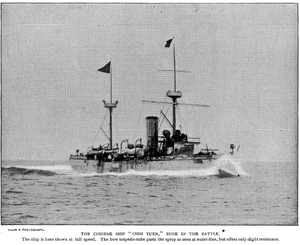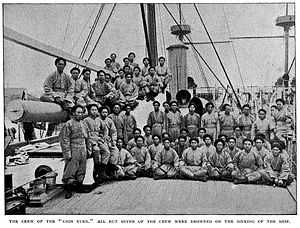Chinese cruiser Zhiyuan
 Chih Yuen around 1894 | |
| Career (China) | |
|---|---|
| Name: | Chih Yuen |
| Builder: | Armstrong Whitworth, Elswick, England |
| Laid down: | 20 October 1885 |
| Launched: | 29 September 1886 |
| Completed: | 23 July 1887 |
| Fate: | Sunk in combat, 17 September 1894 |
| General characteristics | |
| Type: | Protected cruiser |
| Displacement: | 2,355 long tons (2,393 t) |
| Length: | 72.085 m (236 ft 6.0 in) |
| Beam: | 10.05 m (33 ft 0 in) |
| Draft: | 4.8 m (15 ft 9 in) |
| Speed: | 18 kn (33 km/h; 21 mph) |
| Capacity: | 510 tons of coal |
| Complement: | 260 officers and men |
| Armament: | 3 × 210 mm (8.3 in) guns, 2 × 150 mm (5.9 in) guns, 8 × 57 mm (2.2 in) guns, 4 × 457 mm (18.0 in) torpedo tubes |
| Armor: | Belt: 51 mm (2.0 in) Turret: 51 mm (2.0 in) |

Zhiyuan (Chinese: 致遠; pinyin: Zhiyuan; Wade–Giles: Chih Yuen') was a protected cruiser in the late Qing Dynasty Beiyang Fleet. Its sister ship was the 1886 Jingyuen (Ching-Yuen).
Background
As part of his drive to create a modern navy following the Sino-French War, Viceroy Li Hongzhang turned to Armstrong Whitworth shipyards in Elswick, England, which had developed a new type of warship specifically for the export market called the protected cruiser.
Design
Jingyuan was a typical “Elswick” protected cruiser design, with a steel housing, divided into waterproof compartments, a low forecastle, a single smokestack, and two masts. The prow was reinforced for ramming. The power plant was a triple expansion reciprocating steam engine with four cylindrical boilers, driving two screws.
However, the ship was more lightly-armed that typical Elswick designs, with the main armament consisting of three breech-loading 8-inch (209 mm) Krupp cannon, two paired on a rotating platform in front of the ship, and one mounted on a rotating platform in the stern. Both mounts were protected by gun shields. The secondary armament consisted of two 6-inch (149 mm) Armstrong guns mounted on sponsons on either side of the deck. The ship also had eight 57-mm rapid-fire guns and six 37 mm Hotchkiss guns, as well as four torpedos.
Although the most modern vessels in the Beiyang Fleet at the time of the First Sino-Japanese War, Zhiyuan and Jingyuan suffered by comparison with similar Elswick designs in the Imperial Japanese Navy, such as the Izumi, which were more heavily armed.
Service record
Zhiyuan was laid down on 20 October 1885, launched on 29 September 1886, completed on 23 July 1887. On arrival in China in 1888, Zhiyuan and Jingyuan were both assigned to the Beiyang Fleet. In the summer of 1889, both vessels were part of the flotilla let by Admiral Ding Ruchang, calling on the Russian naval base of Vladivostok.
Both vessels were in the Battle of the Yalu River on 17 September 1894. Early in the battle, the captain of Zhiyuan moved aggressively against the Japanese command vessel Saikyō Maru, inflicting considerable damage on it, and coming under counterattack by the Japanese flying squadron led by Admiral Tsuboi Kōzō (Yoshino, Takachiho, Akitsushima, and Naniwa). The Japanese cruisers circled Zhiyuan, firing at a more rapid pace and scoring more hits than the poorly trained and poorly supplied Chinese gunners. Deng Shichang, the captain of Zhiyuan attempted to close on Yoshino (a Japanese source considers it was the Naniwa[1]) to ram, but was hit in the bow by a shell fired from either Naniwa or Takachiho at 15:50 hours, which caused a massive explosion, after which she rapidly sank. Some 245 officers and crewmen out of a 252 complement went down with the ship. Conversely, the captain of Jingyuan kept his distance from combat, and refused to engage the Japanese fleet and escaped the battle with minor damage.
Chinese sources claimed Captain Deng, was pulled on the arm by his pet dog to lifeboat in the water after his ship went down, but refused rescue and eventually disappeared under the waves with his dog.[2] A subsequent report concludes that during the battle, "The braves were too rash, they charged without order, while the cowards (Fang Boqian and Wu Jingrong) were too cowardly,they ran without order".[3]
References
- ↑ Jukkoku Matsuda,Tōgō heihachirō to akiyama saneyuki ,PHP Kenkyūjo, 2008, p.187
- ↑ Is Deng's Dog So Inexusable?
- ↑ http://mil.chinaiiss.com/html/20104/7/a249e7_2.html
- Chesneau, Roger and Eugene M. Kolesnik (editors), All The World's Fighting Ships 1860-1905, Conway Maritime Press, 1979 reprinted 2002, ISBN 0-85177-133-5
- Wright, Richard N. J. (2000). The Chinese Steam Navy 1862-1945. London: Chatham Publishing. ISBN 1-86176-144-9.
Coordinates: 39°12′50″N 123°07′35″E / 39.21389°N 123.12639°E